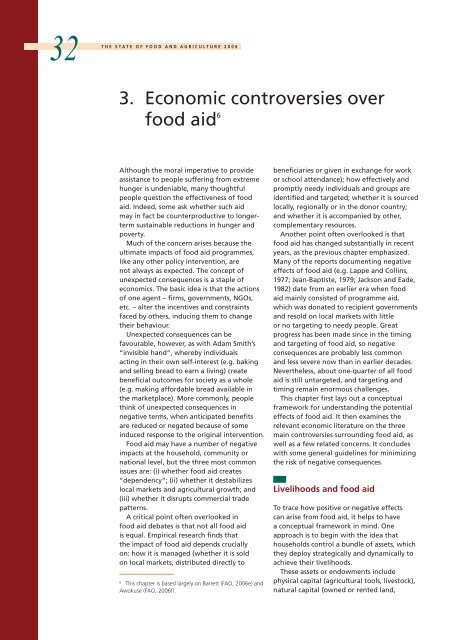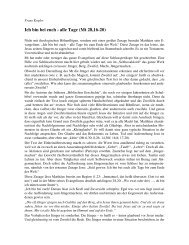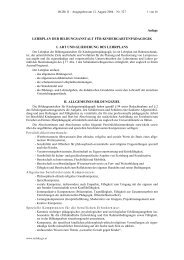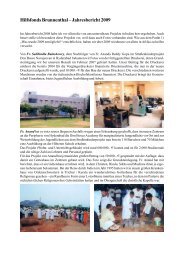The State of Food and Agriculture - FAO
The State of Food and Agriculture - FAO
The State of Food and Agriculture - FAO
You also want an ePaper? Increase the reach of your titles
YUMPU automatically turns print PDFs into web optimized ePapers that Google loves.
32<br />
THE STATE OF FOOD AND AGRICULTURE 2006<br />
3. Economic controversies over<br />
food aid 6<br />
Although the moral imperative to provide<br />
assistance to people suffering from extreme<br />
hunger is undeniable, many thoughtful<br />
people question the effectiveness <strong>of</strong> food<br />
aid. Indeed, some ask whether such aid<br />
may in fact be counterproductive to longerterm<br />
sustainable reductions in hunger <strong>and</strong><br />
poverty.<br />
Much <strong>of</strong> the concern arises because the<br />
ultimate impacts <strong>of</strong> food aid programmes,<br />
like any other policy intervention, are<br />
not always as expected. <strong>The</strong> concept <strong>of</strong><br />
unexpected consequences is a staple <strong>of</strong><br />
economics. <strong>The</strong> basic idea is that the actions<br />
<strong>of</strong> one agent – firms, governments, NGOs,<br />
etc. – alter the incentives <strong>and</strong> constraints<br />
faced by others, inducing them to change<br />
their behaviour.<br />
Unexpected consequences can be<br />
favourable, however, as with Adam Smith’s<br />
“invisible h<strong>and</strong>”, whereby individuals<br />
acting in their own self-interest (e.g. baking<br />
<strong>and</strong> selling bread to earn a living) create<br />
beneficial outcomes for society as a whole<br />
(e.g. making affordable bread available in<br />
the marketplace). More commonly, people<br />
think <strong>of</strong> unexpected consequences in<br />
negative terms, when anticipated benefits<br />
are reduced or negated because <strong>of</strong> some<br />
induced response to the original intervention.<br />
<strong>Food</strong> aid may have a number <strong>of</strong> negative<br />
impacts at the household, community or<br />
national level, but the three most common<br />
issues are: (i) whether food aid creates<br />
“dependency”; (ii) whether it destabilizes<br />
local markets <strong>and</strong> agricultural growth; <strong>and</strong><br />
(iii) whether it disrupts commercial trade<br />
patterns.<br />
A critical point <strong>of</strong>ten overlooked in<br />
food aid debates is that not all food aid<br />
is equal. Empirical research finds that<br />
the impact <strong>of</strong> food aid depends crucially<br />
on: how it is managed (whether it is sold<br />
on local markets, distributed directly to<br />
6 This chapter is based largely on Barrett (<strong>FAO</strong>, 2006e) <strong>and</strong><br />
Awokuse (<strong>FAO</strong>, 2006f).<br />
beneficiaries or given in exchange for work<br />
or school attendance); how effectively <strong>and</strong><br />
promptly needy individuals <strong>and</strong> groups are<br />
identified <strong>and</strong> targeted; whether it is sourced<br />
locally, regionally or in the donor country;<br />
<strong>and</strong> whether it is accompanied by other,<br />
complementary resources.<br />
Another point <strong>of</strong>ten overlooked is that<br />
food aid has changed substantially in recent<br />
years, as the previous chapter emphasized.<br />
Many <strong>of</strong> the reports documenting negative<br />
effects <strong>of</strong> food aid (e.g. Lappe <strong>and</strong> Collins,<br />
1977; Jean-Baptiste, 1979; Jackson <strong>and</strong> Eade,<br />
1982) date from an earlier era when food<br />
aid mainly consisted <strong>of</strong> programme aid,<br />
which was donated to recipient governments<br />
<strong>and</strong> resold on local markets with little<br />
or no targeting to needy people. Great<br />
progress has been made since in the timing<br />
<strong>and</strong> targeting <strong>of</strong> food aid, so negative<br />
consequences are probably less common<br />
<strong>and</strong> less severe now than in earlier decades.<br />
Nevertheless, about one-quarter <strong>of</strong> all food<br />
aid is still untargeted, <strong>and</strong> targeting <strong>and</strong><br />
timing remain enormous challenges.<br />
This chapter first lays out a conceptual<br />
framework for underst<strong>and</strong>ing the potential<br />
effects <strong>of</strong> food aid. It then examines the<br />
relevant economic literature on the three<br />
main controversies surrounding food aid, as<br />
well as a few related concerns. It concludes<br />
with some general guidelines for minimizing<br />
the risk <strong>of</strong> negative consequences.<br />
Livelihoods <strong>and</strong> food aid<br />
To trace how positive or negative effects<br />
can arise from food aid, it helps to have<br />
a conceptual framework in mind. One<br />
approach is to begin with the idea that<br />
households control a bundle <strong>of</strong> assets, which<br />
they deploy strategically <strong>and</strong> dynamically to<br />
achieve their livelihoods.<br />
<strong>The</strong>se assets or endowments include<br />
physical capital (agricultural tools, livestock),<br />
natural capital (owned or rented l<strong>and</strong>,

















